Financial Accounting: Financial Ratio Analysis and CGU Identification
VerifiedAdded on 2023/06/12
|13
|3035
|169
Report
AI Summary
This assignment provides solutions to questions related to financial accounting. It includes an analysis of cash-generating units (CGUs) according to AASB 136 for Wentnor Dairy Company Ltd, focusing on identifying CGUs within a vertically integrated structure. Additionally, it performs a financial ratio analysis of Woolworths Ltd, assessing profitability, capital structure, solvency, and efficiency using key ratios. The report interprets the implications of these ratios, particularly concerning liquidity and investment potential. Finally, it discusses the interpretation of foreign currency transactions in the context of Qantas Ltd's annual report, explaining the use of current rate processes and the impact of exchange rate variations.
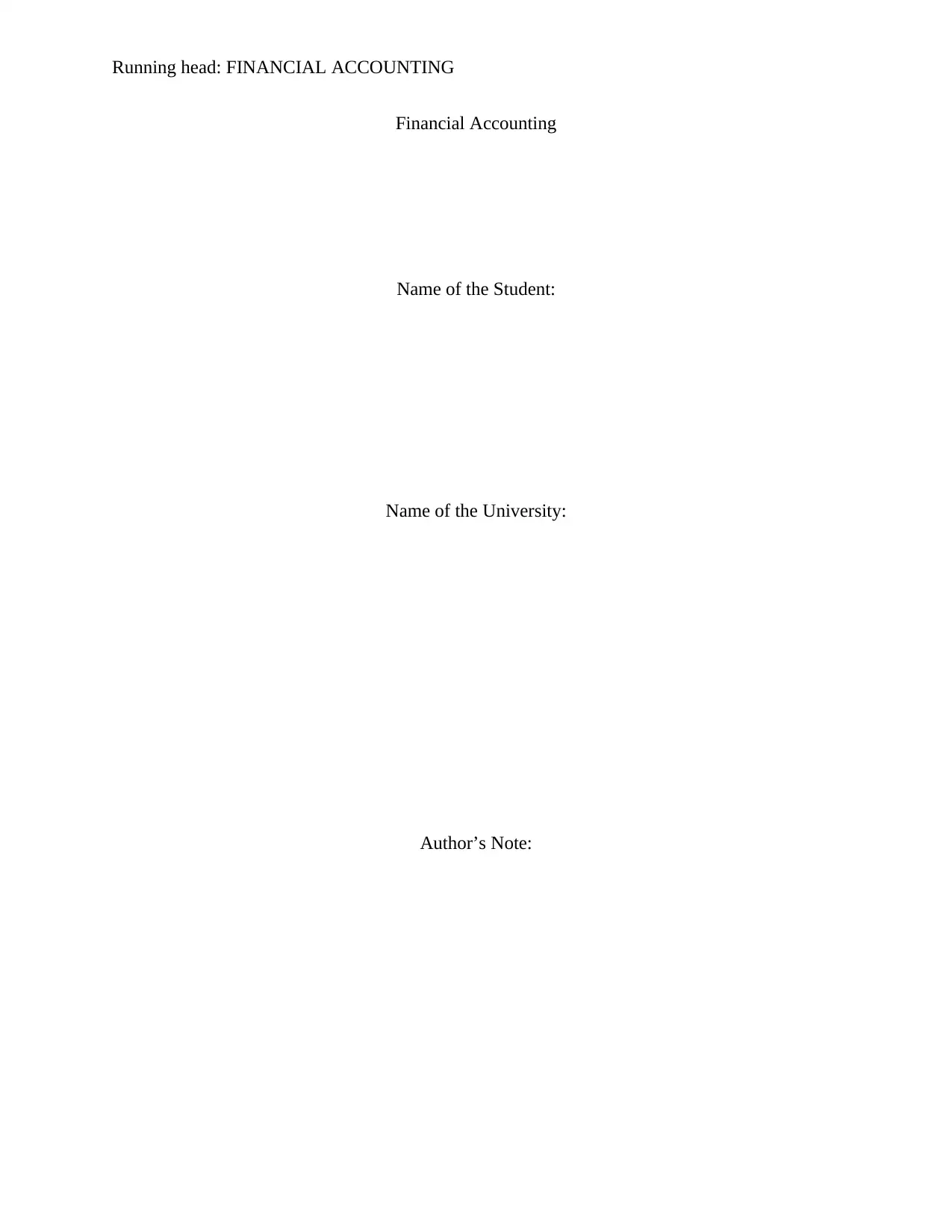
Running head: FINANCIAL ACCOUNTING
Financial Accounting
Name of the Student:
Name of the University:
Author’s Note:
Financial Accounting
Name of the Student:
Name of the University:
Author’s Note:
Paraphrase This Document
Need a fresh take? Get an instant paraphrase of this document with our AI Paraphraser
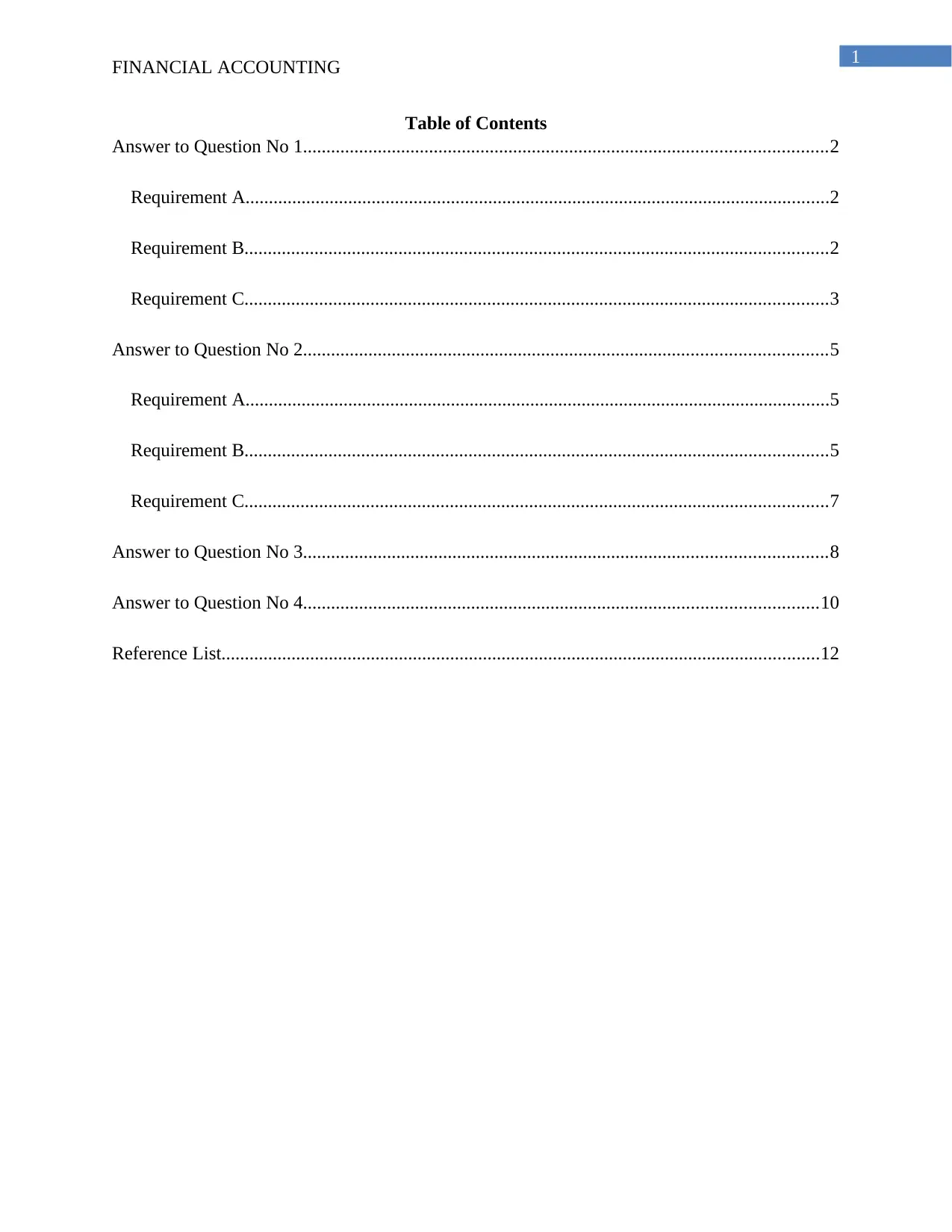
1
FINANCIAL ACCOUNTING
Table of Contents
Answer to Question No 1................................................................................................................2
Requirement A.............................................................................................................................2
Requirement B.............................................................................................................................2
Requirement C.............................................................................................................................3
Answer to Question No 2................................................................................................................5
Requirement A.............................................................................................................................5
Requirement B.............................................................................................................................5
Requirement C.............................................................................................................................7
Answer to Question No 3................................................................................................................8
Answer to Question No 4..............................................................................................................10
Reference List................................................................................................................................12
FINANCIAL ACCOUNTING
Table of Contents
Answer to Question No 1................................................................................................................2
Requirement A.............................................................................................................................2
Requirement B.............................................................................................................................2
Requirement C.............................................................................................................................3
Answer to Question No 2................................................................................................................5
Requirement A.............................................................................................................................5
Requirement B.............................................................................................................................5
Requirement C.............................................................................................................................7
Answer to Question No 3................................................................................................................8
Answer to Question No 4..............................................................................................................10
Reference List................................................................................................................................12
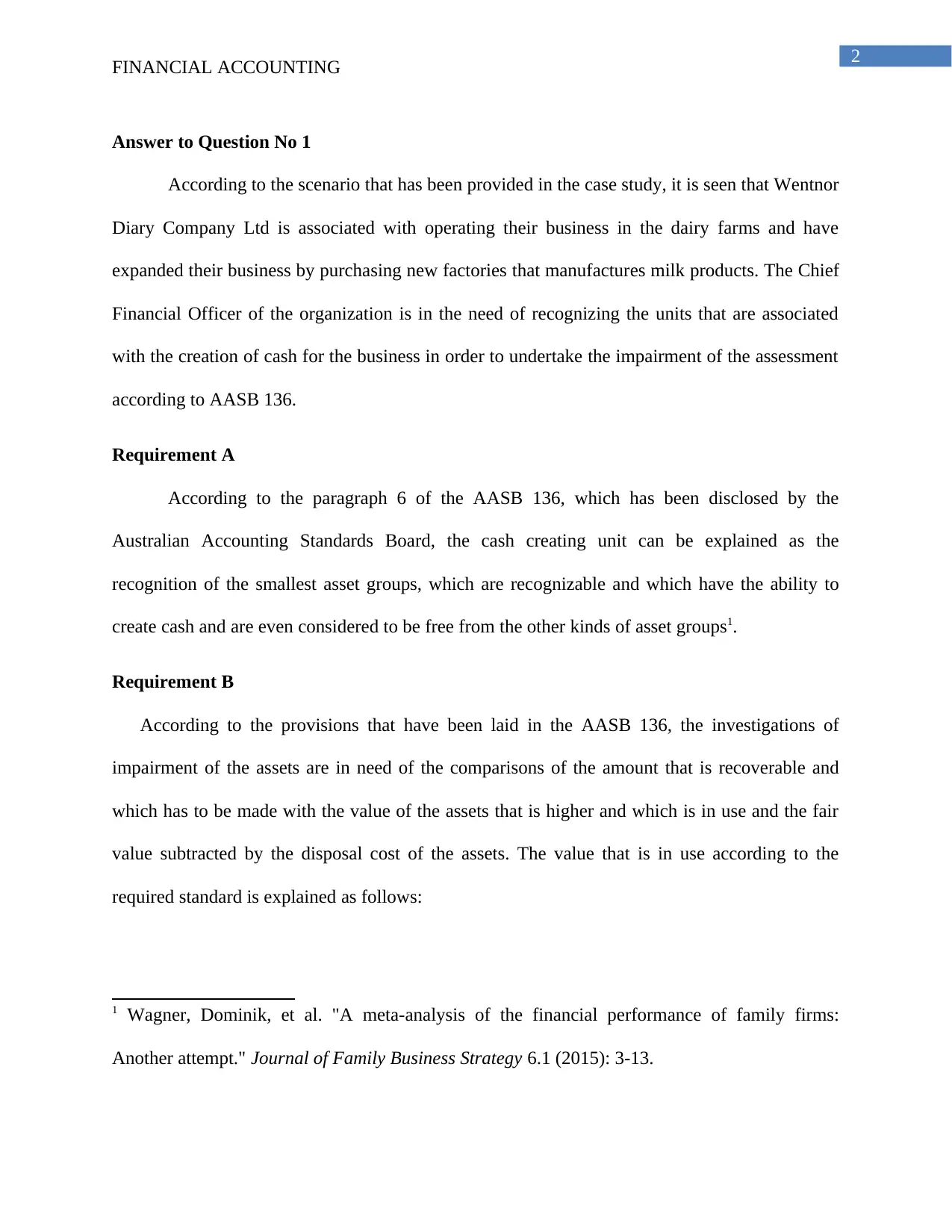
2
FINANCIAL ACCOUNTING
Answer to Question No 1
According to the scenario that has been provided in the case study, it is seen that Wentnor
Diary Company Ltd is associated with operating their business in the dairy farms and have
expanded their business by purchasing new factories that manufactures milk products. The Chief
Financial Officer of the organization is in the need of recognizing the units that are associated
with the creation of cash for the business in order to undertake the impairment of the assessment
according to AASB 136.
Requirement A
According to the paragraph 6 of the AASB 136, which has been disclosed by the
Australian Accounting Standards Board, the cash creating unit can be explained as the
recognition of the smallest asset groups, which are recognizable and which have the ability to
create cash and are even considered to be free from the other kinds of asset groups1.
Requirement B
According to the provisions that have been laid in the AASB 136, the investigations of
impairment of the assets are in need of the comparisons of the amount that is recoverable and
which has to be made with the value of the assets that is higher and which is in use and the fair
value subtracted by the disposal cost of the assets. The value that is in use according to the
required standard is explained as follows:
1 Wagner, Dominik, et al. "A meta-analysis of the financial performance of family firms:
Another attempt." Journal of Family Business Strategy 6.1 (2015): 3-13.
FINANCIAL ACCOUNTING
Answer to Question No 1
According to the scenario that has been provided in the case study, it is seen that Wentnor
Diary Company Ltd is associated with operating their business in the dairy farms and have
expanded their business by purchasing new factories that manufactures milk products. The Chief
Financial Officer of the organization is in the need of recognizing the units that are associated
with the creation of cash for the business in order to undertake the impairment of the assessment
according to AASB 136.
Requirement A
According to the paragraph 6 of the AASB 136, which has been disclosed by the
Australian Accounting Standards Board, the cash creating unit can be explained as the
recognition of the smallest asset groups, which are recognizable and which have the ability to
create cash and are even considered to be free from the other kinds of asset groups1.
Requirement B
According to the provisions that have been laid in the AASB 136, the investigations of
impairment of the assets are in need of the comparisons of the amount that is recoverable and
which has to be made with the value of the assets that is higher and which is in use and the fair
value subtracted by the disposal cost of the assets. The value that is in use according to the
required standard is explained as follows:
1 Wagner, Dominik, et al. "A meta-analysis of the financial performance of family firms:
Another attempt." Journal of Family Business Strategy 6.1 (2015): 3-13.
⊘ This is a preview!⊘
Do you want full access?
Subscribe today to unlock all pages.

Trusted by 1+ million students worldwide
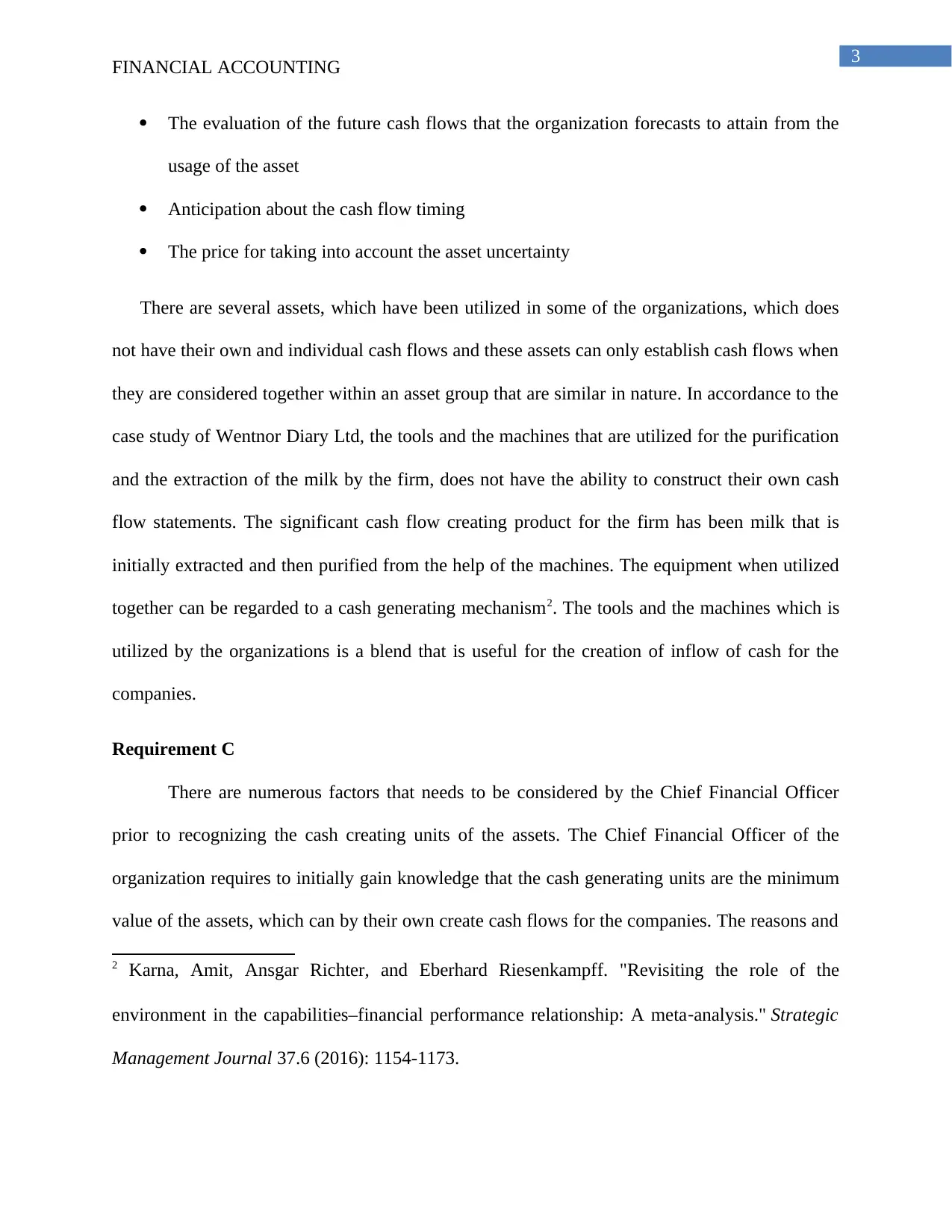
3
FINANCIAL ACCOUNTING
The evaluation of the future cash flows that the organization forecasts to attain from the
usage of the asset
Anticipation about the cash flow timing
The price for taking into account the asset uncertainty
There are several assets, which have been utilized in some of the organizations, which does
not have their own and individual cash flows and these assets can only establish cash flows when
they are considered together within an asset group that are similar in nature. In accordance to the
case study of Wentnor Diary Ltd, the tools and the machines that are utilized for the purification
and the extraction of the milk by the firm, does not have the ability to construct their own cash
flow statements. The significant cash flow creating product for the firm has been milk that is
initially extracted and then purified from the help of the machines. The equipment when utilized
together can be regarded to a cash generating mechanism2. The tools and the machines which is
utilized by the organizations is a blend that is useful for the creation of inflow of cash for the
companies.
Requirement C
There are numerous factors that needs to be considered by the Chief Financial Officer
prior to recognizing the cash creating units of the assets. The Chief Financial Officer of the
organization requires to initially gain knowledge that the cash generating units are the minimum
value of the assets, which can by their own create cash flows for the companies. The reasons and
2 Karna, Amit, Ansgar Richter, and Eberhard Riesenkampff. "Revisiting the role of the
environment in the capabilities–financial performance relationship: A meta‐analysis." Strategic
Management Journal 37.6 (2016): 1154-1173.
FINANCIAL ACCOUNTING
The evaluation of the future cash flows that the organization forecasts to attain from the
usage of the asset
Anticipation about the cash flow timing
The price for taking into account the asset uncertainty
There are several assets, which have been utilized in some of the organizations, which does
not have their own and individual cash flows and these assets can only establish cash flows when
they are considered together within an asset group that are similar in nature. In accordance to the
case study of Wentnor Diary Ltd, the tools and the machines that are utilized for the purification
and the extraction of the milk by the firm, does not have the ability to construct their own cash
flow statements. The significant cash flow creating product for the firm has been milk that is
initially extracted and then purified from the help of the machines. The equipment when utilized
together can be regarded to a cash generating mechanism2. The tools and the machines which is
utilized by the organizations is a blend that is useful for the creation of inflow of cash for the
companies.
Requirement C
There are numerous factors that needs to be considered by the Chief Financial Officer
prior to recognizing the cash creating units of the assets. The Chief Financial Officer of the
organization requires to initially gain knowledge that the cash generating units are the minimum
value of the assets, which can by their own create cash flows for the companies. The reasons and
2 Karna, Amit, Ansgar Richter, and Eberhard Riesenkampff. "Revisiting the role of the
environment in the capabilities–financial performance relationship: A meta‐analysis." Strategic
Management Journal 37.6 (2016): 1154-1173.
Paraphrase This Document
Need a fresh take? Get an instant paraphrase of this document with our AI Paraphraser
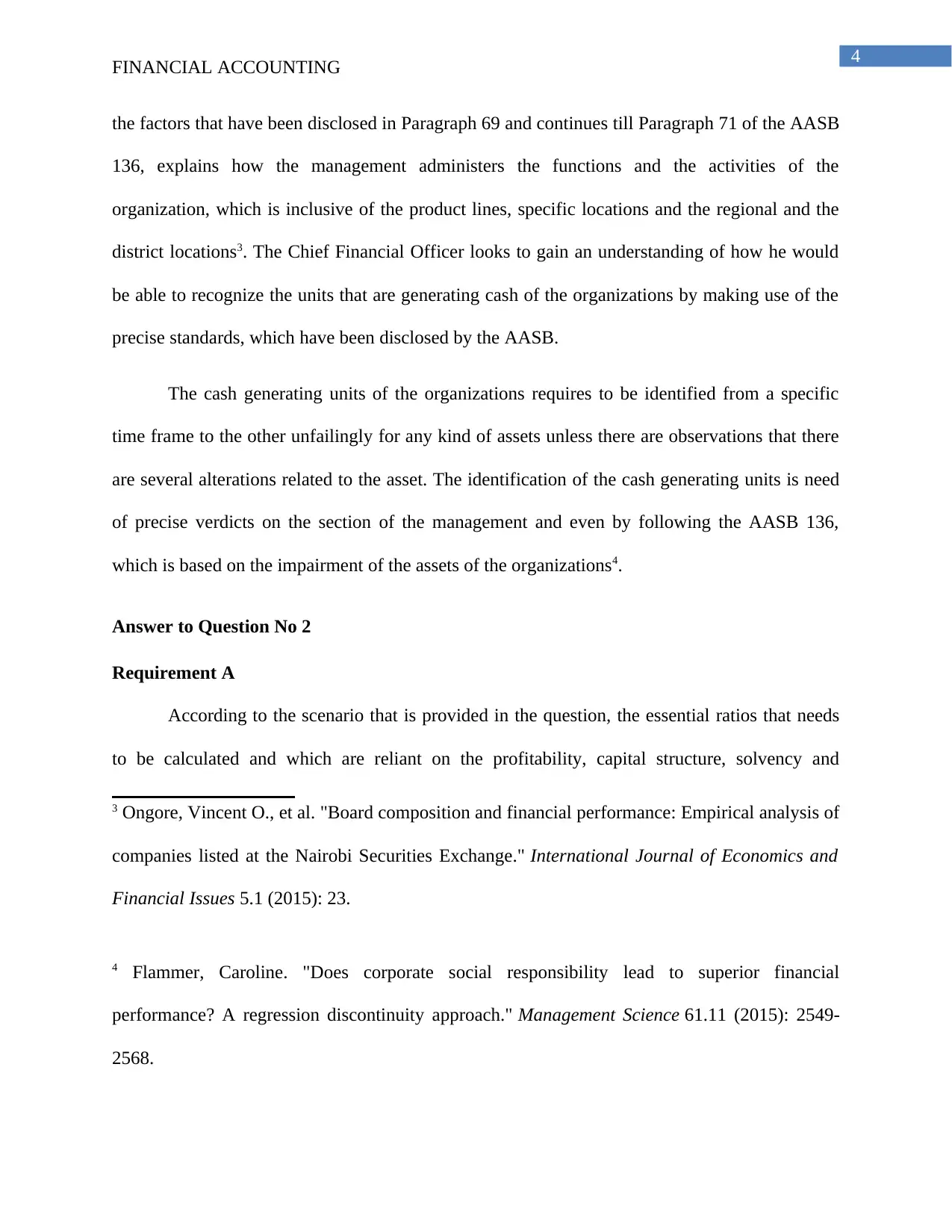
4
FINANCIAL ACCOUNTING
the factors that have been disclosed in Paragraph 69 and continues till Paragraph 71 of the AASB
136, explains how the management administers the functions and the activities of the
organization, which is inclusive of the product lines, specific locations and the regional and the
district locations3. The Chief Financial Officer looks to gain an understanding of how he would
be able to recognize the units that are generating cash of the organizations by making use of the
precise standards, which have been disclosed by the AASB.
The cash generating units of the organizations requires to be identified from a specific
time frame to the other unfailingly for any kind of assets unless there are observations that there
are several alterations related to the asset. The identification of the cash generating units is need
of precise verdicts on the section of the management and even by following the AASB 136,
which is based on the impairment of the assets of the organizations4.
Answer to Question No 2
Requirement A
According to the scenario that is provided in the question, the essential ratios that needs
to be calculated and which are reliant on the profitability, capital structure, solvency and
3 Ongore, Vincent O., et al. "Board composition and financial performance: Empirical analysis of
companies listed at the Nairobi Securities Exchange." International Journal of Economics and
Financial Issues 5.1 (2015): 23.
4 Flammer, Caroline. "Does corporate social responsibility lead to superior financial
performance? A regression discontinuity approach." Management Science 61.11 (2015): 2549-
2568.
FINANCIAL ACCOUNTING
the factors that have been disclosed in Paragraph 69 and continues till Paragraph 71 of the AASB
136, explains how the management administers the functions and the activities of the
organization, which is inclusive of the product lines, specific locations and the regional and the
district locations3. The Chief Financial Officer looks to gain an understanding of how he would
be able to recognize the units that are generating cash of the organizations by making use of the
precise standards, which have been disclosed by the AASB.
The cash generating units of the organizations requires to be identified from a specific
time frame to the other unfailingly for any kind of assets unless there are observations that there
are several alterations related to the asset. The identification of the cash generating units is need
of precise verdicts on the section of the management and even by following the AASB 136,
which is based on the impairment of the assets of the organizations4.
Answer to Question No 2
Requirement A
According to the scenario that is provided in the question, the essential ratios that needs
to be calculated and which are reliant on the profitability, capital structure, solvency and
3 Ongore, Vincent O., et al. "Board composition and financial performance: Empirical analysis of
companies listed at the Nairobi Securities Exchange." International Journal of Economics and
Financial Issues 5.1 (2015): 23.
4 Flammer, Caroline. "Does corporate social responsibility lead to superior financial
performance? A regression discontinuity approach." Management Science 61.11 (2015): 2549-
2568.
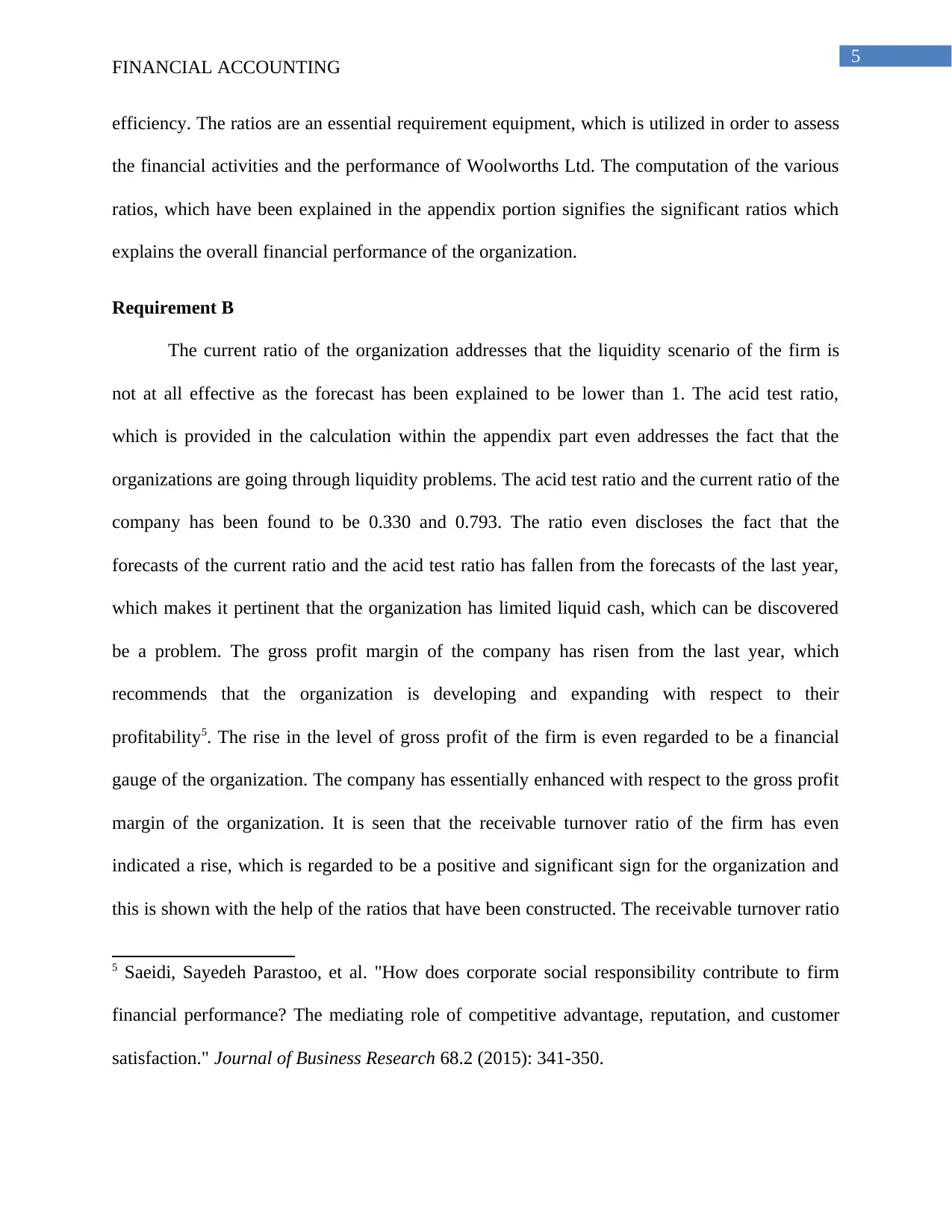
5
FINANCIAL ACCOUNTING
efficiency. The ratios are an essential requirement equipment, which is utilized in order to assess
the financial activities and the performance of Woolworths Ltd. The computation of the various
ratios, which have been explained in the appendix portion signifies the significant ratios which
explains the overall financial performance of the organization.
Requirement B
The current ratio of the organization addresses that the liquidity scenario of the firm is
not at all effective as the forecast has been explained to be lower than 1. The acid test ratio,
which is provided in the calculation within the appendix part even addresses the fact that the
organizations are going through liquidity problems. The acid test ratio and the current ratio of the
company has been found to be 0.330 and 0.793. The ratio even discloses the fact that the
forecasts of the current ratio and the acid test ratio has fallen from the forecasts of the last year,
which makes it pertinent that the organization has limited liquid cash, which can be discovered
be a problem. The gross profit margin of the company has risen from the last year, which
recommends that the organization is developing and expanding with respect to their
profitability5. The rise in the level of gross profit of the firm is even regarded to be a financial
gauge of the organization. The company has essentially enhanced with respect to the gross profit
margin of the organization. It is seen that the receivable turnover ratio of the firm has even
indicated a rise, which is regarded to be a positive and significant sign for the organization and
this is shown with the help of the ratios that have been constructed. The receivable turnover ratio
5 Saeidi, Sayedeh Parastoo, et al. "How does corporate social responsibility contribute to firm
financial performance? The mediating role of competitive advantage, reputation, and customer
satisfaction." Journal of Business Research 68.2 (2015): 341-350.
FINANCIAL ACCOUNTING
efficiency. The ratios are an essential requirement equipment, which is utilized in order to assess
the financial activities and the performance of Woolworths Ltd. The computation of the various
ratios, which have been explained in the appendix portion signifies the significant ratios which
explains the overall financial performance of the organization.
Requirement B
The current ratio of the organization addresses that the liquidity scenario of the firm is
not at all effective as the forecast has been explained to be lower than 1. The acid test ratio,
which is provided in the calculation within the appendix part even addresses the fact that the
organizations are going through liquidity problems. The acid test ratio and the current ratio of the
company has been found to be 0.330 and 0.793. The ratio even discloses the fact that the
forecasts of the current ratio and the acid test ratio has fallen from the forecasts of the last year,
which makes it pertinent that the organization has limited liquid cash, which can be discovered
be a problem. The gross profit margin of the company has risen from the last year, which
recommends that the organization is developing and expanding with respect to their
profitability5. The rise in the level of gross profit of the firm is even regarded to be a financial
gauge of the organization. The company has essentially enhanced with respect to the gross profit
margin of the organization. It is seen that the receivable turnover ratio of the firm has even
indicated a rise, which is regarded to be a positive and significant sign for the organization and
this is shown with the help of the ratios that have been constructed. The receivable turnover ratio
5 Saeidi, Sayedeh Parastoo, et al. "How does corporate social responsibility contribute to firm
financial performance? The mediating role of competitive advantage, reputation, and customer
satisfaction." Journal of Business Research 68.2 (2015): 341-350.
⊘ This is a preview!⊘
Do you want full access?
Subscribe today to unlock all pages.

Trusted by 1+ million students worldwide
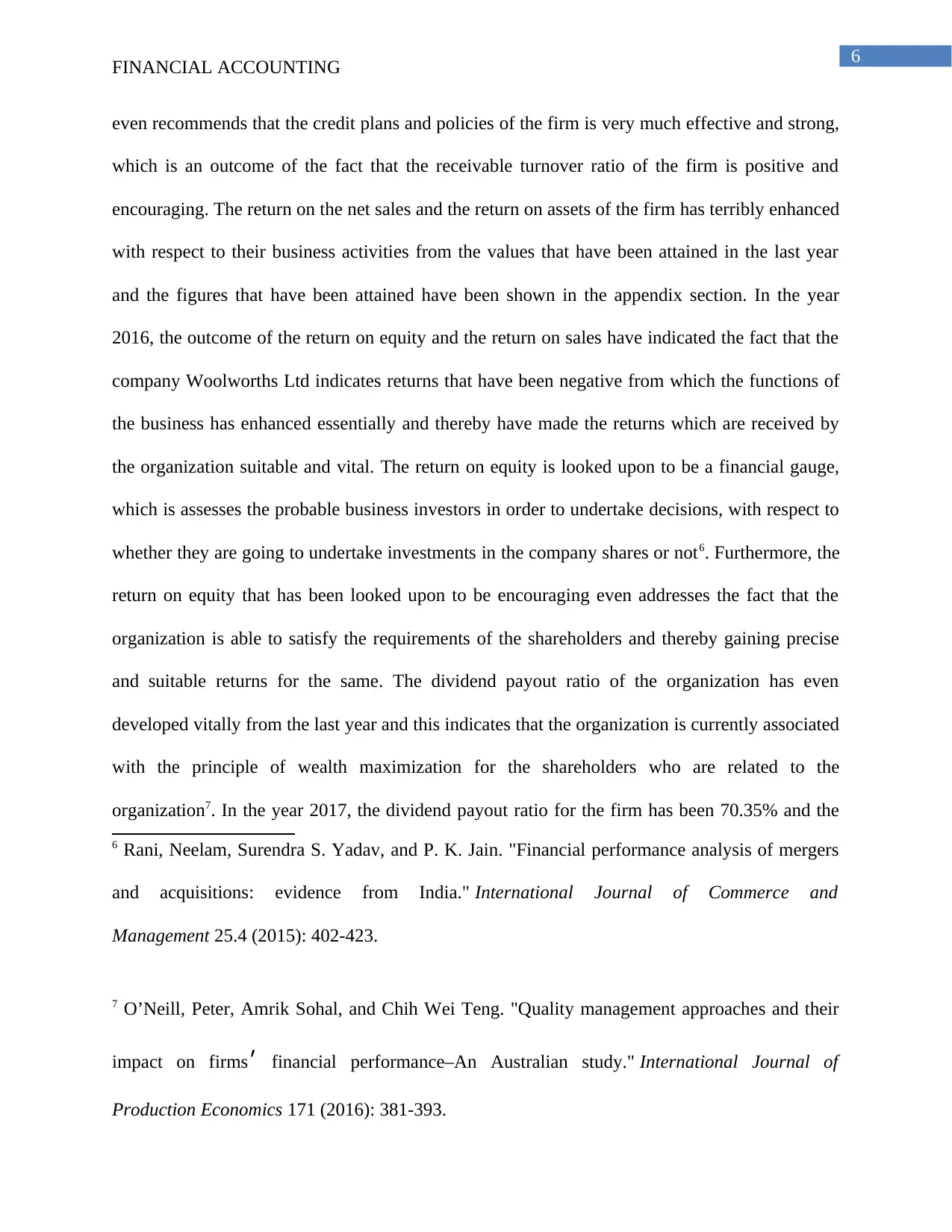
6
FINANCIAL ACCOUNTING
even recommends that the credit plans and policies of the firm is very much effective and strong,
which is an outcome of the fact that the receivable turnover ratio of the firm is positive and
encouraging. The return on the net sales and the return on assets of the firm has terribly enhanced
with respect to their business activities from the values that have been attained in the last year
and the figures that have been attained have been shown in the appendix section. In the year
2016, the outcome of the return on equity and the return on sales have indicated the fact that the
company Woolworths Ltd indicates returns that have been negative from which the functions of
the business has enhanced essentially and thereby have made the returns which are received by
the organization suitable and vital. The return on equity is looked upon to be a financial gauge,
which is assesses the probable business investors in order to undertake decisions, with respect to
whether they are going to undertake investments in the company shares or not6. Furthermore, the
return on equity that has been looked upon to be encouraging even addresses the fact that the
organization is able to satisfy the requirements of the shareholders and thereby gaining precise
and suitable returns for the same. The dividend payout ratio of the organization has even
developed vitally from the last year and this indicates that the organization is currently associated
with the principle of wealth maximization for the shareholders who are related to the
organization7. In the year 2017, the dividend payout ratio for the firm has been 70.35% and the
6 Rani, Neelam, Surendra S. Yadav, and P. K. Jain. "Financial performance analysis of mergers
and acquisitions: evidence from India." International Journal of Commerce and
Management 25.4 (2015): 402-423.
7 O’Neill, Peter, Amrik Sohal, and Chih Wei Teng. "Quality management approaches and their
impact on firms׳ financial performance–An Australian study." International Journal of
Production Economics 171 (2016): 381-393.
FINANCIAL ACCOUNTING
even recommends that the credit plans and policies of the firm is very much effective and strong,
which is an outcome of the fact that the receivable turnover ratio of the firm is positive and
encouraging. The return on the net sales and the return on assets of the firm has terribly enhanced
with respect to their business activities from the values that have been attained in the last year
and the figures that have been attained have been shown in the appendix section. In the year
2016, the outcome of the return on equity and the return on sales have indicated the fact that the
company Woolworths Ltd indicates returns that have been negative from which the functions of
the business has enhanced essentially and thereby have made the returns which are received by
the organization suitable and vital. The return on equity is looked upon to be a financial gauge,
which is assesses the probable business investors in order to undertake decisions, with respect to
whether they are going to undertake investments in the company shares or not6. Furthermore, the
return on equity that has been looked upon to be encouraging even addresses the fact that the
organization is able to satisfy the requirements of the shareholders and thereby gaining precise
and suitable returns for the same. The dividend payout ratio of the organization has even
developed vitally from the last year and this indicates that the organization is currently associated
with the principle of wealth maximization for the shareholders who are related to the
organization7. In the year 2017, the dividend payout ratio for the firm has been 70.35% and the
6 Rani, Neelam, Surendra S. Yadav, and P. K. Jain. "Financial performance analysis of mergers
and acquisitions: evidence from India." International Journal of Commerce and
Management 25.4 (2015): 402-423.
7 O’Neill, Peter, Amrik Sohal, and Chih Wei Teng. "Quality management approaches and their
impact on firms׳ financial performance–An Australian study." International Journal of
Production Economics 171 (2016): 381-393.
Paraphrase This Document
Need a fresh take? Get an instant paraphrase of this document with our AI Paraphraser
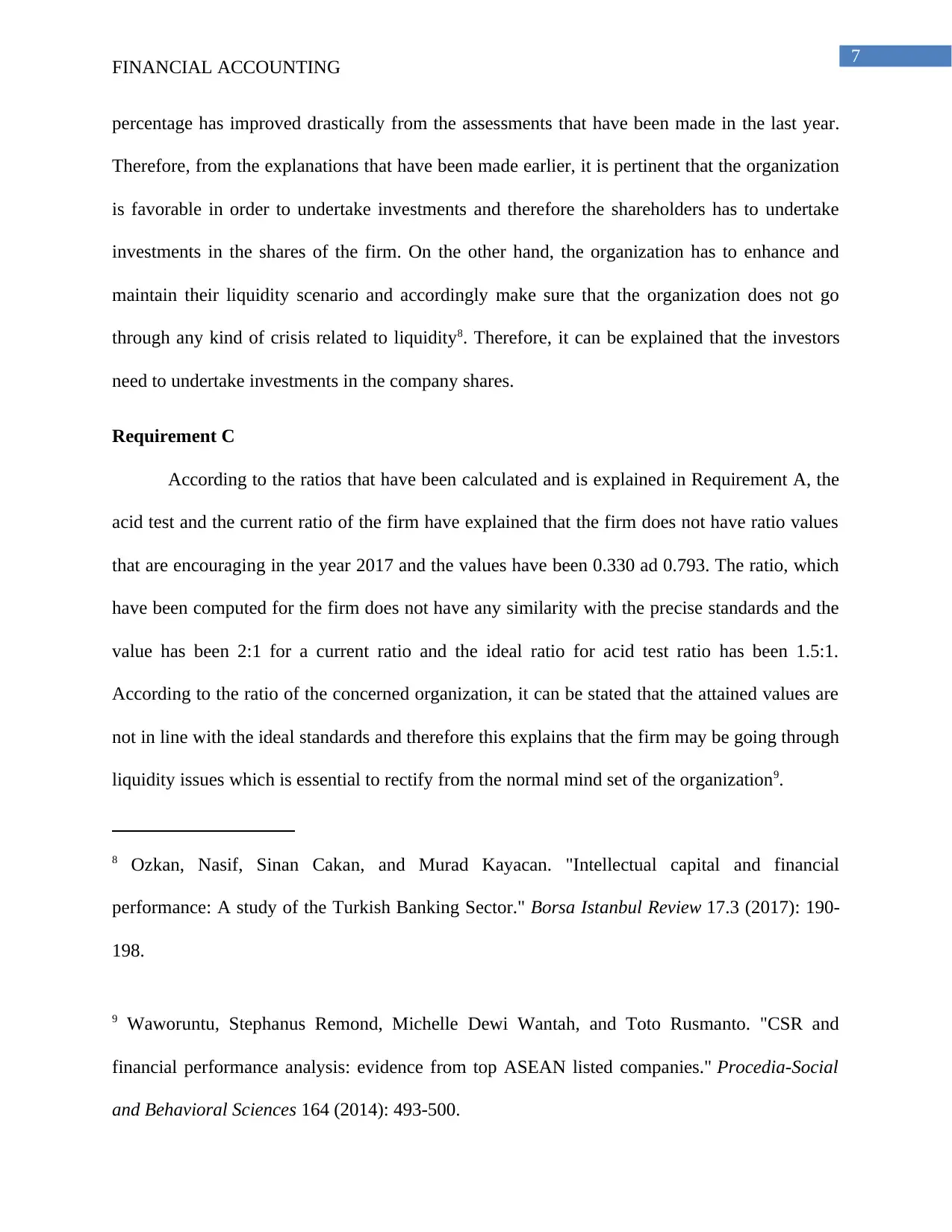
7
FINANCIAL ACCOUNTING
percentage has improved drastically from the assessments that have been made in the last year.
Therefore, from the explanations that have been made earlier, it is pertinent that the organization
is favorable in order to undertake investments and therefore the shareholders has to undertake
investments in the shares of the firm. On the other hand, the organization has to enhance and
maintain their liquidity scenario and accordingly make sure that the organization does not go
through any kind of crisis related to liquidity8. Therefore, it can be explained that the investors
need to undertake investments in the company shares.
Requirement C
According to the ratios that have been calculated and is explained in Requirement A, the
acid test and the current ratio of the firm have explained that the firm does not have ratio values
that are encouraging in the year 2017 and the values have been 0.330 ad 0.793. The ratio, which
have been computed for the firm does not have any similarity with the precise standards and the
value has been 2:1 for a current ratio and the ideal ratio for acid test ratio has been 1.5:1.
According to the ratio of the concerned organization, it can be stated that the attained values are
not in line with the ideal standards and therefore this explains that the firm may be going through
liquidity issues which is essential to rectify from the normal mind set of the organization9.
8 Ozkan, Nasif, Sinan Cakan, and Murad Kayacan. "Intellectual capital and financial
performance: A study of the Turkish Banking Sector." Borsa Istanbul Review 17.3 (2017): 190-
198.
9 Waworuntu, Stephanus Remond, Michelle Dewi Wantah, and Toto Rusmanto. "CSR and
financial performance analysis: evidence from top ASEAN listed companies." Procedia-Social
and Behavioral Sciences 164 (2014): 493-500.
FINANCIAL ACCOUNTING
percentage has improved drastically from the assessments that have been made in the last year.
Therefore, from the explanations that have been made earlier, it is pertinent that the organization
is favorable in order to undertake investments and therefore the shareholders has to undertake
investments in the shares of the firm. On the other hand, the organization has to enhance and
maintain their liquidity scenario and accordingly make sure that the organization does not go
through any kind of crisis related to liquidity8. Therefore, it can be explained that the investors
need to undertake investments in the company shares.
Requirement C
According to the ratios that have been calculated and is explained in Requirement A, the
acid test and the current ratio of the firm have explained that the firm does not have ratio values
that are encouraging in the year 2017 and the values have been 0.330 ad 0.793. The ratio, which
have been computed for the firm does not have any similarity with the precise standards and the
value has been 2:1 for a current ratio and the ideal ratio for acid test ratio has been 1.5:1.
According to the ratio of the concerned organization, it can be stated that the attained values are
not in line with the ideal standards and therefore this explains that the firm may be going through
liquidity issues which is essential to rectify from the normal mind set of the organization9.
8 Ozkan, Nasif, Sinan Cakan, and Murad Kayacan. "Intellectual capital and financial
performance: A study of the Turkish Banking Sector." Borsa Istanbul Review 17.3 (2017): 190-
198.
9 Waworuntu, Stephanus Remond, Michelle Dewi Wantah, and Toto Rusmanto. "CSR and
financial performance analysis: evidence from top ASEAN listed companies." Procedia-Social
and Behavioral Sciences 164 (2014): 493-500.
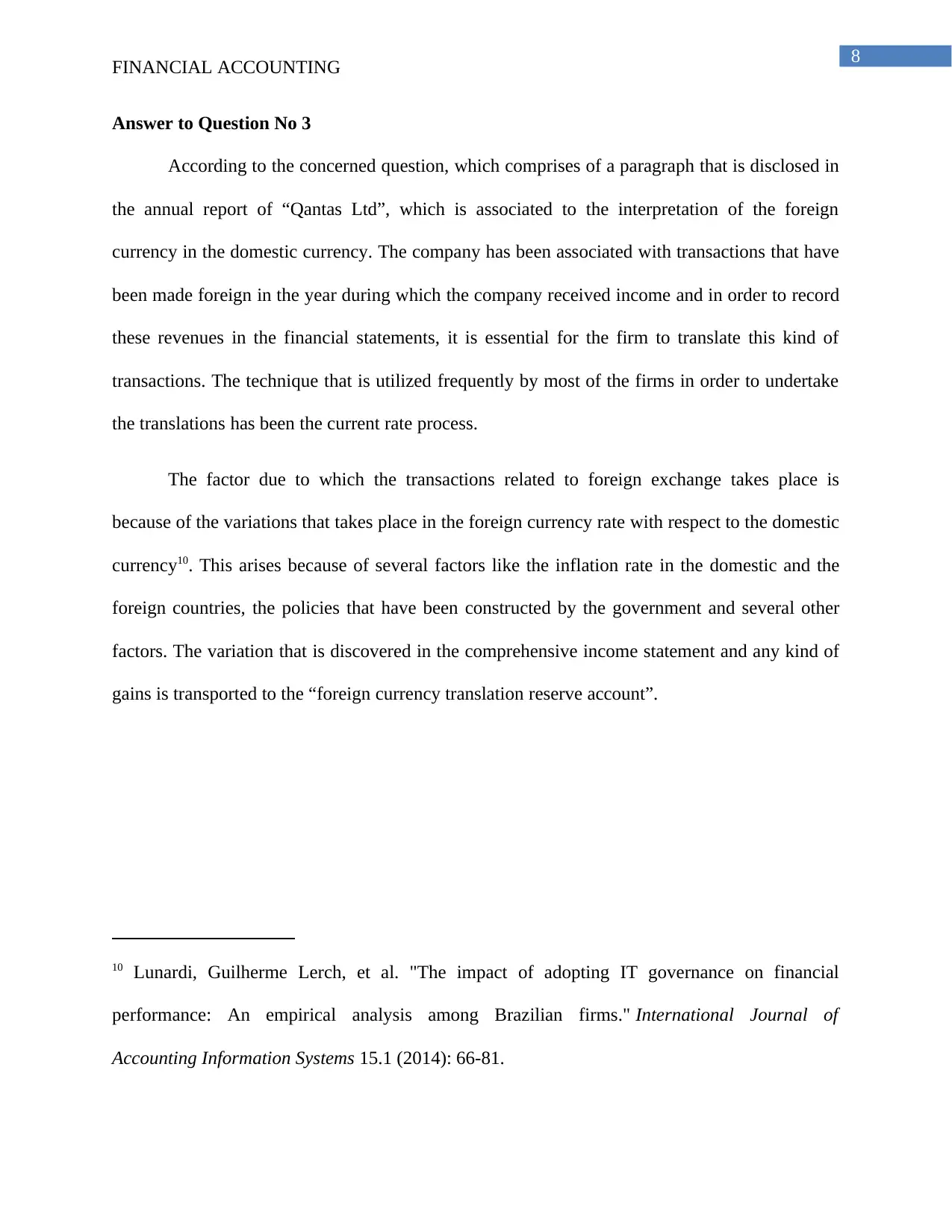
8
FINANCIAL ACCOUNTING
Answer to Question No 3
According to the concerned question, which comprises of a paragraph that is disclosed in
the annual report of “Qantas Ltd”, which is associated to the interpretation of the foreign
currency in the domestic currency. The company has been associated with transactions that have
been made foreign in the year during which the company received income and in order to record
these revenues in the financial statements, it is essential for the firm to translate this kind of
transactions. The technique that is utilized frequently by most of the firms in order to undertake
the translations has been the current rate process.
The factor due to which the transactions related to foreign exchange takes place is
because of the variations that takes place in the foreign currency rate with respect to the domestic
currency10. This arises because of several factors like the inflation rate in the domestic and the
foreign countries, the policies that have been constructed by the government and several other
factors. The variation that is discovered in the comprehensive income statement and any kind of
gains is transported to the “foreign currency translation reserve account”.
10 Lunardi, Guilherme Lerch, et al. "The impact of adopting IT governance on financial
performance: An empirical analysis among Brazilian firms." International Journal of
Accounting Information Systems 15.1 (2014): 66-81.
FINANCIAL ACCOUNTING
Answer to Question No 3
According to the concerned question, which comprises of a paragraph that is disclosed in
the annual report of “Qantas Ltd”, which is associated to the interpretation of the foreign
currency in the domestic currency. The company has been associated with transactions that have
been made foreign in the year during which the company received income and in order to record
these revenues in the financial statements, it is essential for the firm to translate this kind of
transactions. The technique that is utilized frequently by most of the firms in order to undertake
the translations has been the current rate process.
The factor due to which the transactions related to foreign exchange takes place is
because of the variations that takes place in the foreign currency rate with respect to the domestic
currency10. This arises because of several factors like the inflation rate in the domestic and the
foreign countries, the policies that have been constructed by the government and several other
factors. The variation that is discovered in the comprehensive income statement and any kind of
gains is transported to the “foreign currency translation reserve account”.
10 Lunardi, Guilherme Lerch, et al. "The impact of adopting IT governance on financial
performance: An empirical analysis among Brazilian firms." International Journal of
Accounting Information Systems 15.1 (2014): 66-81.
⊘ This is a preview!⊘
Do you want full access?
Subscribe today to unlock all pages.

Trusted by 1+ million students worldwide
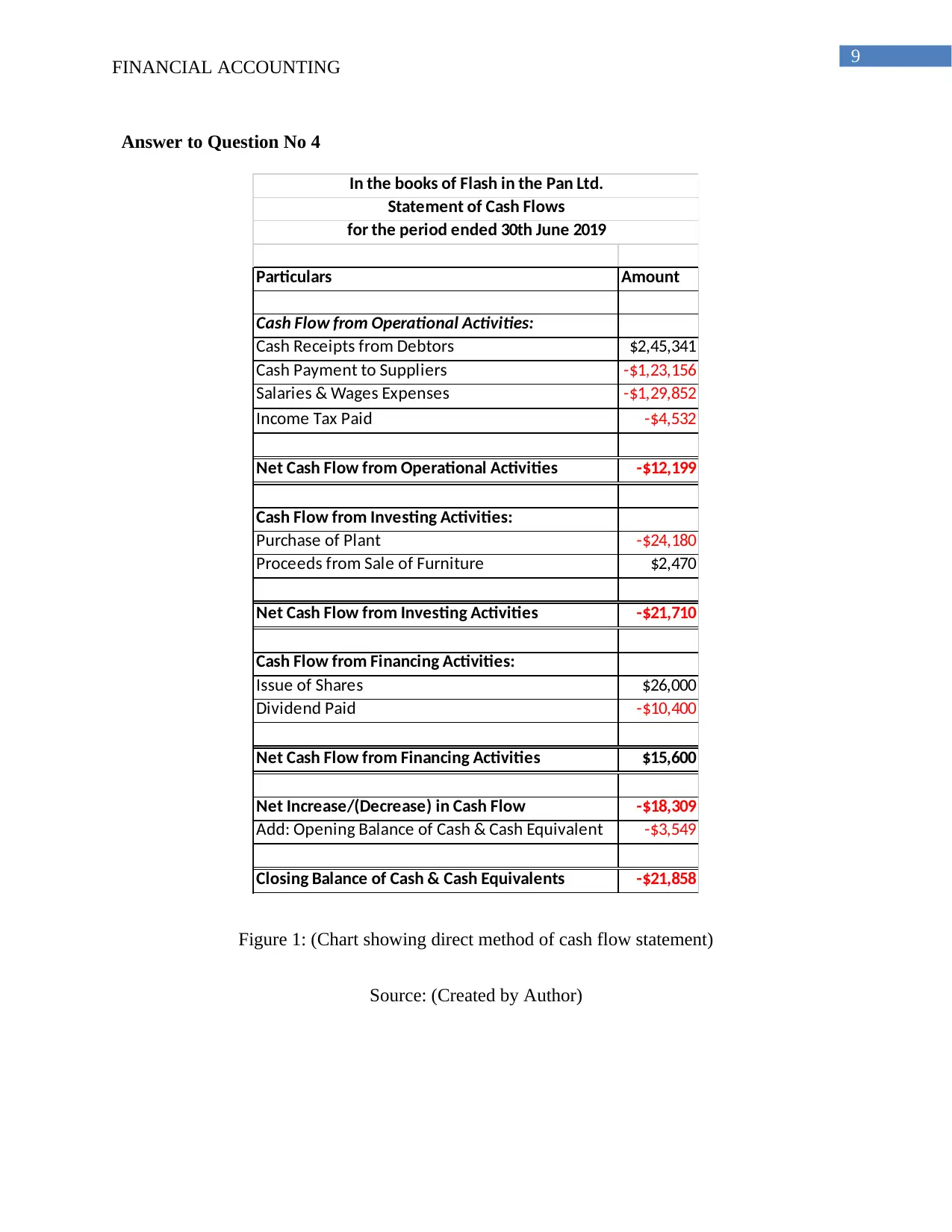
9
FINANCIAL ACCOUNTING
Answer to Question No 4
Particulars Amount
Cash Flow from Operational Activities:
Cash Receipts from Debtors $2,45,341
Cash Payment to Suppliers -$1,23,156
Salaries & Wages Expenses -$1,29,852
Income Tax Paid -$4,532
Net Cash Flow from Operational Activities -$12,199
Cash Flow from Investing Activities:
Purchase of Plant -$24,180
Proceeds from Sale of Furniture $2,470
Net Cash Flow from Investing Activities -$21,710
Cash Flow from Financing Activities:
Issue of Shares $26,000
Dividend Paid -$10,400
Net Cash Flow from Financing Activities $15,600
Net Increase/(Decrease) in Cash Flow -$18,309
Add: Opening Balance of Cash & Cash Equivalent -$3,549
Closing Balance of Cash & Cash Equivalents -$21,858
In the books of Flash in the Pan Ltd.
Statement of Cash Flows
for the period ended 30th June 2019
Figure 1: (Chart showing direct method of cash flow statement)
Source: (Created by Author)
FINANCIAL ACCOUNTING
Answer to Question No 4
Particulars Amount
Cash Flow from Operational Activities:
Cash Receipts from Debtors $2,45,341
Cash Payment to Suppliers -$1,23,156
Salaries & Wages Expenses -$1,29,852
Income Tax Paid -$4,532
Net Cash Flow from Operational Activities -$12,199
Cash Flow from Investing Activities:
Purchase of Plant -$24,180
Proceeds from Sale of Furniture $2,470
Net Cash Flow from Investing Activities -$21,710
Cash Flow from Financing Activities:
Issue of Shares $26,000
Dividend Paid -$10,400
Net Cash Flow from Financing Activities $15,600
Net Increase/(Decrease) in Cash Flow -$18,309
Add: Opening Balance of Cash & Cash Equivalent -$3,549
Closing Balance of Cash & Cash Equivalents -$21,858
In the books of Flash in the Pan Ltd.
Statement of Cash Flows
for the period ended 30th June 2019
Figure 1: (Chart showing direct method of cash flow statement)
Source: (Created by Author)
Paraphrase This Document
Need a fresh take? Get an instant paraphrase of this document with our AI Paraphraser
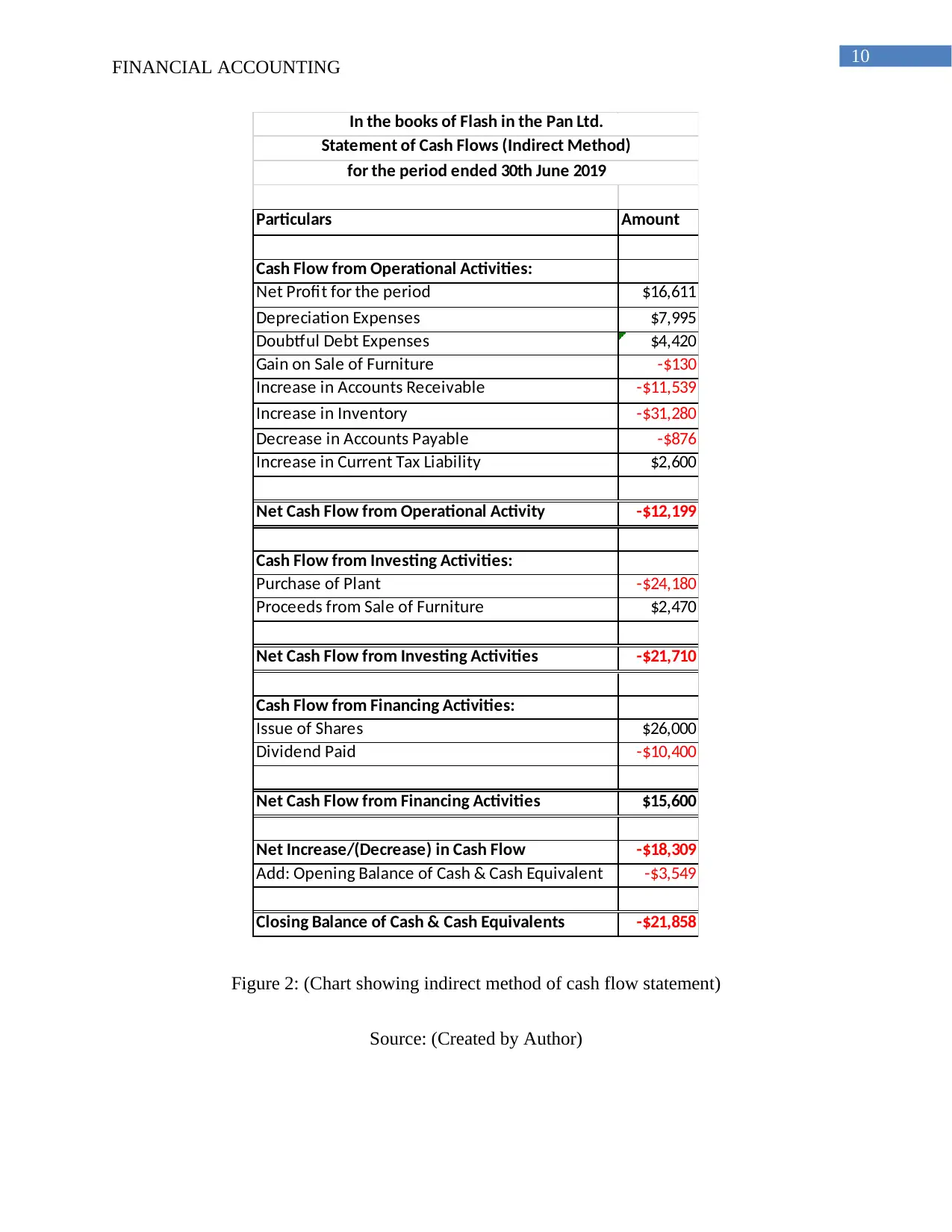
10
FINANCIAL ACCOUNTING
Particulars Amount
Cash Flow from Operational Activities:
Net Profit for the period $16,611
Depreciation Expenses $7,995
Doubtful Debt Expenses $4,420
Gain on Sale of Furniture -$130
Increase in Accounts Receivable -$11,539
Increase in Inventory -$31,280
Decrease in Accounts Payable -$876
Increase in Current Tax Liability $2,600
Net Cash Flow from Operational Activity -$12,199
Cash Flow from Investing Activities:
Purchase of Plant -$24,180
Proceeds from Sale of Furniture $2,470
Net Cash Flow from Investing Activities -$21,710
Cash Flow from Financing Activities:
Issue of Shares $26,000
Dividend Paid -$10,400
Net Cash Flow from Financing Activities $15,600
Net Increase/(Decrease) in Cash Flow -$18,309
Add: Opening Balance of Cash & Cash Equivalent -$3,549
Closing Balance of Cash & Cash Equivalents -$21,858
In the books of Flash in the Pan Ltd.
Statement of Cash Flows (Indirect Method)
for the period ended 30th June 2019
Figure 2: (Chart showing indirect method of cash flow statement)
Source: (Created by Author)
FINANCIAL ACCOUNTING
Particulars Amount
Cash Flow from Operational Activities:
Net Profit for the period $16,611
Depreciation Expenses $7,995
Doubtful Debt Expenses $4,420
Gain on Sale of Furniture -$130
Increase in Accounts Receivable -$11,539
Increase in Inventory -$31,280
Decrease in Accounts Payable -$876
Increase in Current Tax Liability $2,600
Net Cash Flow from Operational Activity -$12,199
Cash Flow from Investing Activities:
Purchase of Plant -$24,180
Proceeds from Sale of Furniture $2,470
Net Cash Flow from Investing Activities -$21,710
Cash Flow from Financing Activities:
Issue of Shares $26,000
Dividend Paid -$10,400
Net Cash Flow from Financing Activities $15,600
Net Increase/(Decrease) in Cash Flow -$18,309
Add: Opening Balance of Cash & Cash Equivalent -$3,549
Closing Balance of Cash & Cash Equivalents -$21,858
In the books of Flash in the Pan Ltd.
Statement of Cash Flows (Indirect Method)
for the period ended 30th June 2019
Figure 2: (Chart showing indirect method of cash flow statement)
Source: (Created by Author)
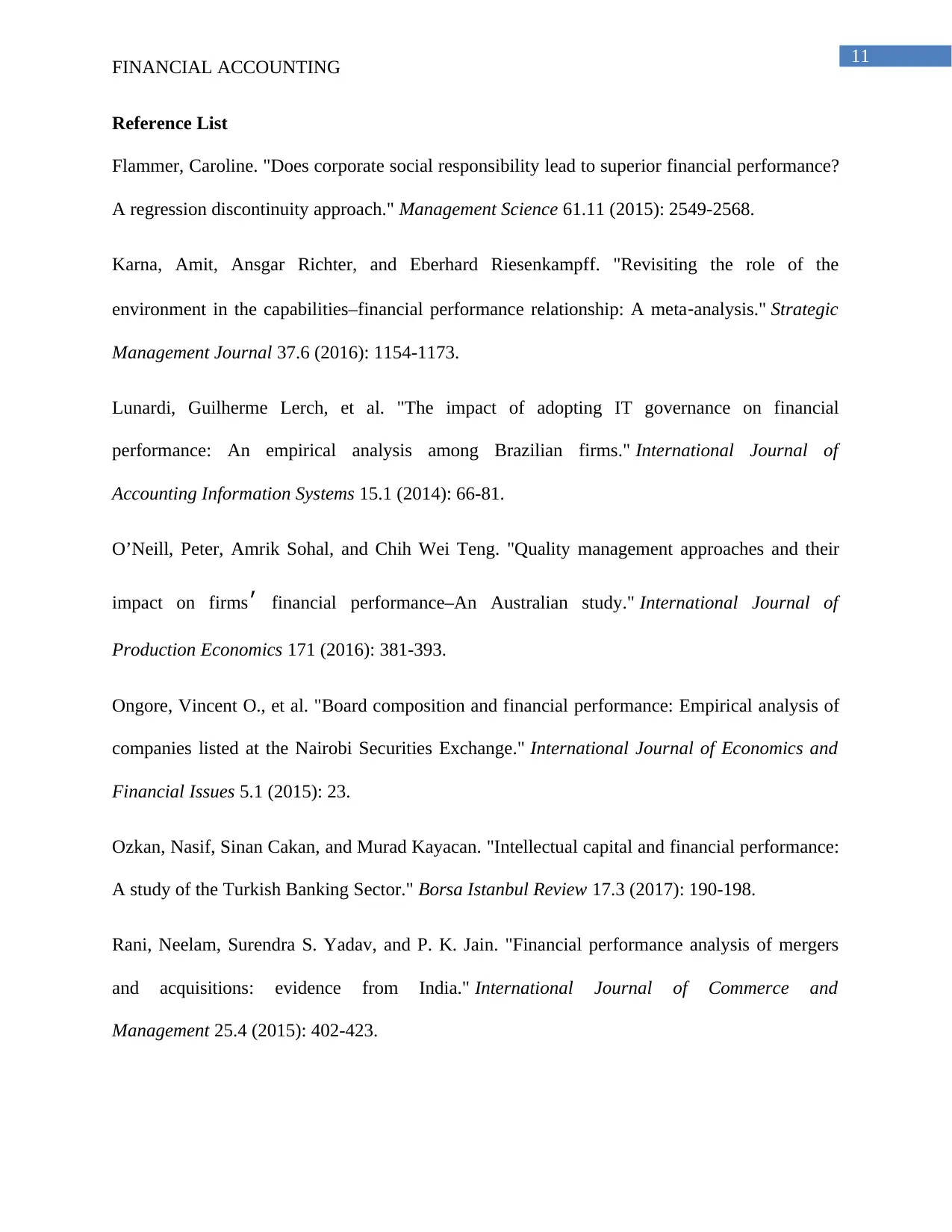
11
FINANCIAL ACCOUNTING
Reference List
Flammer, Caroline. "Does corporate social responsibility lead to superior financial performance?
A regression discontinuity approach." Management Science 61.11 (2015): 2549-2568.
Karna, Amit, Ansgar Richter, and Eberhard Riesenkampff. "Revisiting the role of the
environment in the capabilities–financial performance relationship: A meta‐analysis." Strategic
Management Journal 37.6 (2016): 1154-1173.
Lunardi, Guilherme Lerch, et al. "The impact of adopting IT governance on financial
performance: An empirical analysis among Brazilian firms." International Journal of
Accounting Information Systems 15.1 (2014): 66-81.
O’Neill, Peter, Amrik Sohal, and Chih Wei Teng. "Quality management approaches and their
impact on firms׳ financial performance–An Australian study." International Journal of
Production Economics 171 (2016): 381-393.
Ongore, Vincent O., et al. "Board composition and financial performance: Empirical analysis of
companies listed at the Nairobi Securities Exchange." International Journal of Economics and
Financial Issues 5.1 (2015): 23.
Ozkan, Nasif, Sinan Cakan, and Murad Kayacan. "Intellectual capital and financial performance:
A study of the Turkish Banking Sector." Borsa Istanbul Review 17.3 (2017): 190-198.
Rani, Neelam, Surendra S. Yadav, and P. K. Jain. "Financial performance analysis of mergers
and acquisitions: evidence from India." International Journal of Commerce and
Management 25.4 (2015): 402-423.
FINANCIAL ACCOUNTING
Reference List
Flammer, Caroline. "Does corporate social responsibility lead to superior financial performance?
A regression discontinuity approach." Management Science 61.11 (2015): 2549-2568.
Karna, Amit, Ansgar Richter, and Eberhard Riesenkampff. "Revisiting the role of the
environment in the capabilities–financial performance relationship: A meta‐analysis." Strategic
Management Journal 37.6 (2016): 1154-1173.
Lunardi, Guilherme Lerch, et al. "The impact of adopting IT governance on financial
performance: An empirical analysis among Brazilian firms." International Journal of
Accounting Information Systems 15.1 (2014): 66-81.
O’Neill, Peter, Amrik Sohal, and Chih Wei Teng. "Quality management approaches and their
impact on firms׳ financial performance–An Australian study." International Journal of
Production Economics 171 (2016): 381-393.
Ongore, Vincent O., et al. "Board composition and financial performance: Empirical analysis of
companies listed at the Nairobi Securities Exchange." International Journal of Economics and
Financial Issues 5.1 (2015): 23.
Ozkan, Nasif, Sinan Cakan, and Murad Kayacan. "Intellectual capital and financial performance:
A study of the Turkish Banking Sector." Borsa Istanbul Review 17.3 (2017): 190-198.
Rani, Neelam, Surendra S. Yadav, and P. K. Jain. "Financial performance analysis of mergers
and acquisitions: evidence from India." International Journal of Commerce and
Management 25.4 (2015): 402-423.
⊘ This is a preview!⊘
Do you want full access?
Subscribe today to unlock all pages.

Trusted by 1+ million students worldwide
1 out of 13
Related Documents
Your All-in-One AI-Powered Toolkit for Academic Success.
+13062052269
info@desklib.com
Available 24*7 on WhatsApp / Email
![[object Object]](/_next/static/media/star-bottom.7253800d.svg)
Unlock your academic potential
Copyright © 2020–2025 A2Z Services. All Rights Reserved. Developed and managed by ZUCOL.





